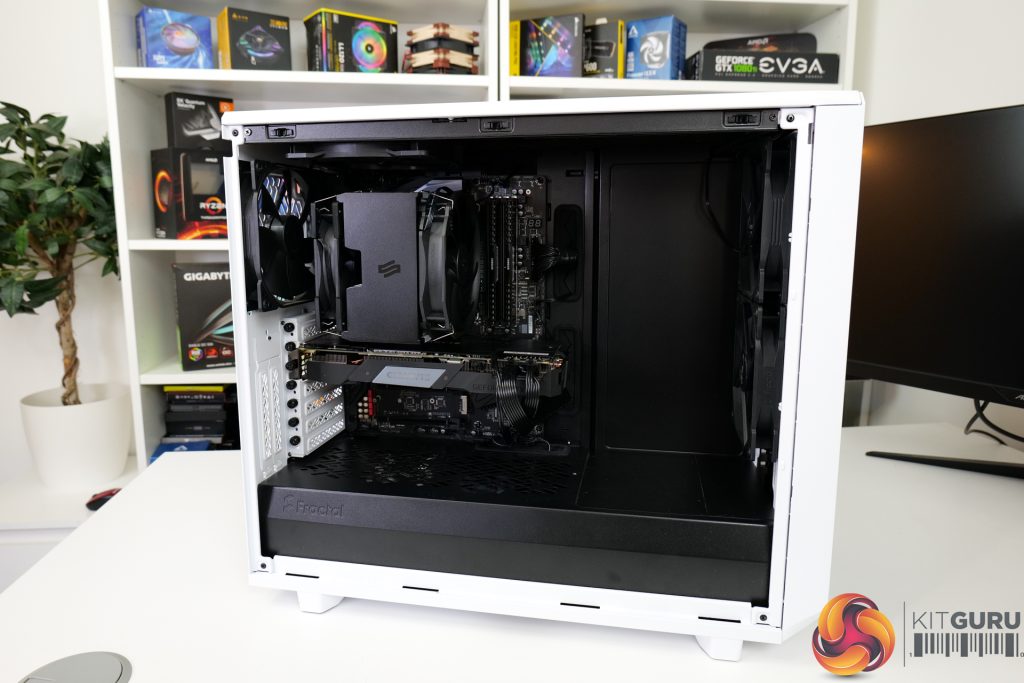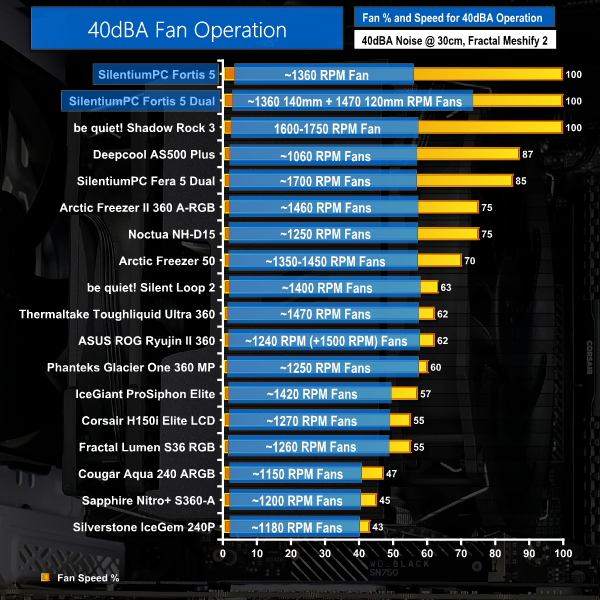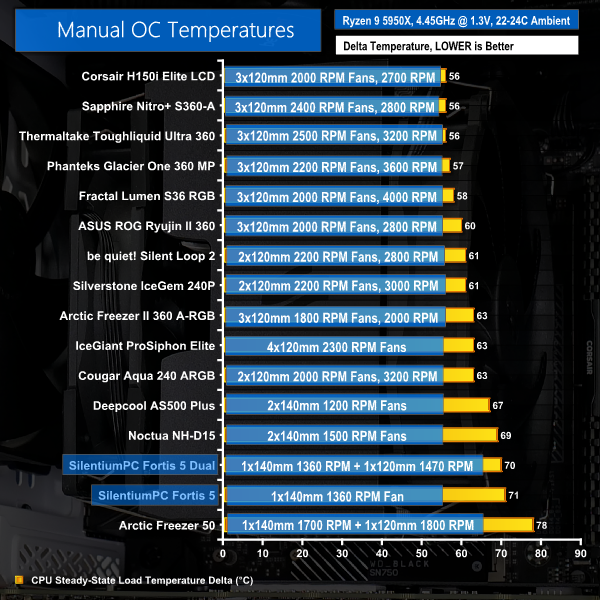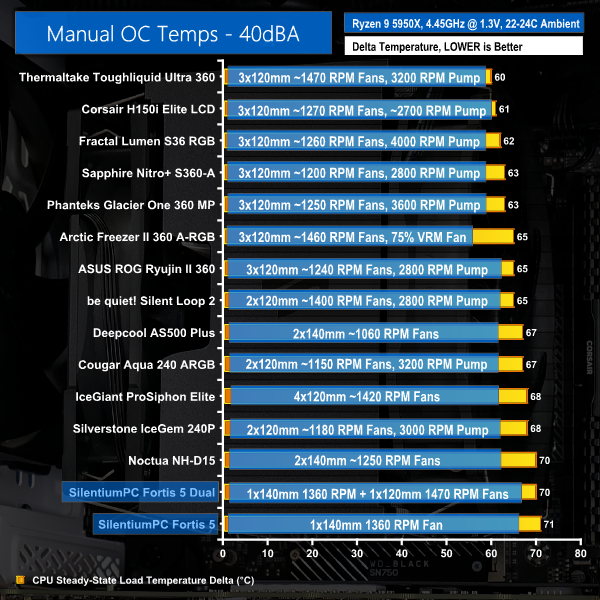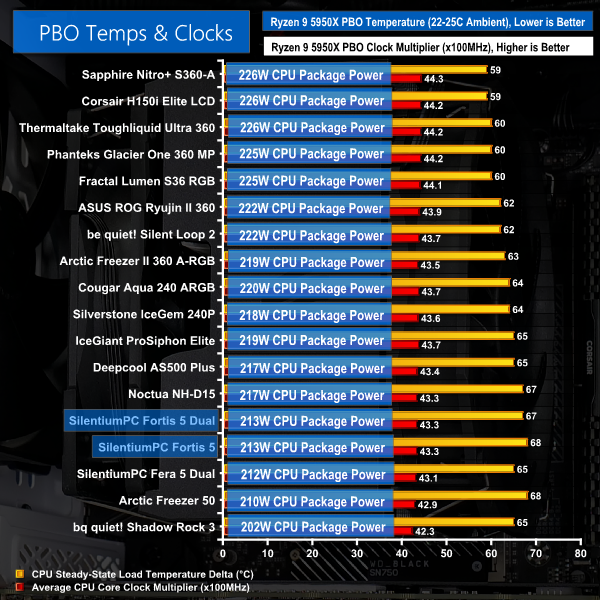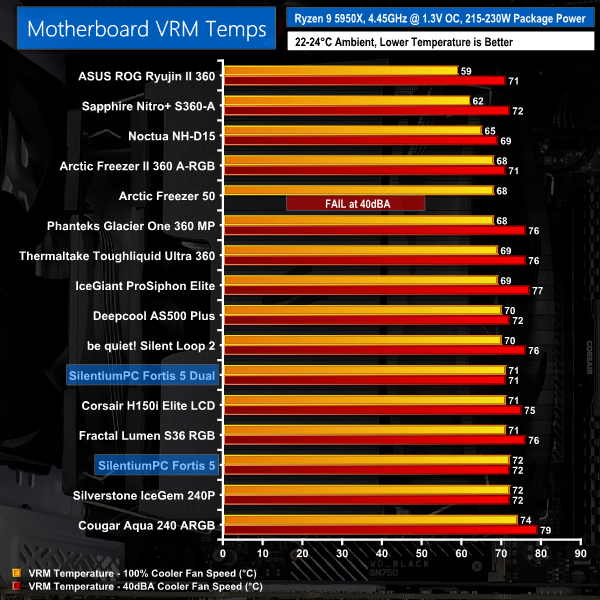Test System:
- Processor: AMD Ryzen 9 5950X
- Overclocked Settings: 4.45GHz all-core @ 1.312V (UEFI), Medium LLC – around 1.3V delivered
- Motherboard: Gigabyte B550 Aorus Master
- Memory: 32GB (2x16GB) Corsair Vengeance LPX 3600MHz 16-18-18-36 DDR4 @ 1.35V
- Graphics Card: Gigabyte RTX 2060 Super 0dB Mode
- Chassis: Fractal Design Meshify 2
- Chassis Fans: 2x140mm 1000 RPM Fractal Front Intake, 1x140mm 1000 RPM Fractal Rear Exhaust, 1x140mm 1000 RPM be quiet! Pure Wings 2 Roof Exhaust (for air cooler testing)
- Power Supply: Seasonic Prime TX-1000
- Operating System: Windows 10 Pro 64-bit
Testing Methodology:
- For testing, we use a 30-minute looped run of Cinebench R23 and record the steady-state CPU temperature at the end of the test. This ensures that the CPU has had ample time to warm up and reach steady state under all of the coolers.
- Ambient is maintained around 22-24 degrees Celsius. Where there is variation beyond this temperature range, we add in extra repeated tests to ensure consistency.
- We also test each cooler with at least two fresh installs (typically three) to mitigate the likelihood of a dodgy mount spoiling results.
Test Results:
Acoustics
Let’s start off with noise performance at 100% fan speed. This is important for getting an indication of where our performance expectations should lie based on noise output.
With an all-round design focused on minimising noise output, it comes as little surprise to see the SilentiumPC Fortis 5 offering superb acoustic results.
With both the single-fan and dual-fan versions rounding to 39 dBA, the SilentiumPC Fortis 5 and Fortis 5 Dual clearly offer exceptional noise performance even at full fan speed. This is a strong testament to the quality of the included fans, albeit with their low top speed rating.
Typically, we would include some reference to 40dBA noise-locked test data. But the SilentiumPC Fortis 5 and Fortis 5 Dual are so quiet at 100% fan speed, that this is not necessary.
We only usually see this type of behaviour with mid-range level, low-noise coolers. So it will be interesting to see if the Fortis 5 can also handle the heat, or whether than fan speeds are just too low for the required level of cooling.
Thermal Performance
With the data entered into our high-end CPU cooler chart, it comes as no surprise to see the Fortis 5 and Fortis 5 Dual positioned where they are. But we have to take a closer look at the results to see the true picture.
All coolers operate at full fan speed in this test, so the fact that SilentiumPC’s single-tower units are able to somewhat keep pace with the bigger dual-tower or dual-fan air coolers, as well as multi-fan AIOs, is impressive.
A comparison versus the Arctic Freezer 50 shows SilentiumPC winning handsomely. And the Fortis 5 Dual performance isn’t too far from the Noctua NH-D15 on our AMD test platform.
With 40dBA noise-locked performance, we do not see any change in the results from the Fortis 5 and Fortis 5 Dual as they were already below this level. However, the margins of performance deficit to some of the bigger and more expensive coolers are no squeezed.
The Arctic Freezer 50 cannot handle this task and therefore drops out of our chart. And some of the 240mm AIOs are within touching distance of the Fortis 5 and Fortis 5 Dual’s numbers when restricted to 40dBA noise output.
This shows off the low-noise operating prowess of the affordable SilentiumPC coolers. Though that roughly £55 Deepcool AS500 Plus continues to be a formidable competitor. And the Cougar Aqua 240 is not very expensive either.
PBO shows a tangible gap in performance between the Fortis 5 and Fortis 5 Dual versus the likes of the Noctua NH-D15, even on our AM4 test platform.
With that said, the Fortis 5 units are perfectly capable of holding their own versus the realistic competitors; Arctic’s Freezer 50 is beaten comfortably and be quiet!’s low-noise optimised Shadow Rock 3 is a notable level of performance behind the SilentiumPC offerings.
Handling 213W of Ryzen 9 5950X package power is a solid result by the Fortis 5.
VRM cooling is absolutely fine at full fan speed. Though, the 40 dBA noise-locked performance comparison is particularly favourable towards SilentiumPC’s coolers.
I was a little disappointed to see the Fortis 5 Dual only dropping MOSFET temperatures by a single degree with its extra fan. This would be one factor in making me think that the upgrade from the Fortis 5 to the Fortis 5 Dual is perhaps not necessary.
 KitGuru KitGuru.net – Tech News | Hardware News | Hardware Reviews | IOS | Mobile | Gaming | Graphics Cards
KitGuru KitGuru.net – Tech News | Hardware News | Hardware Reviews | IOS | Mobile | Gaming | Graphics Cards


